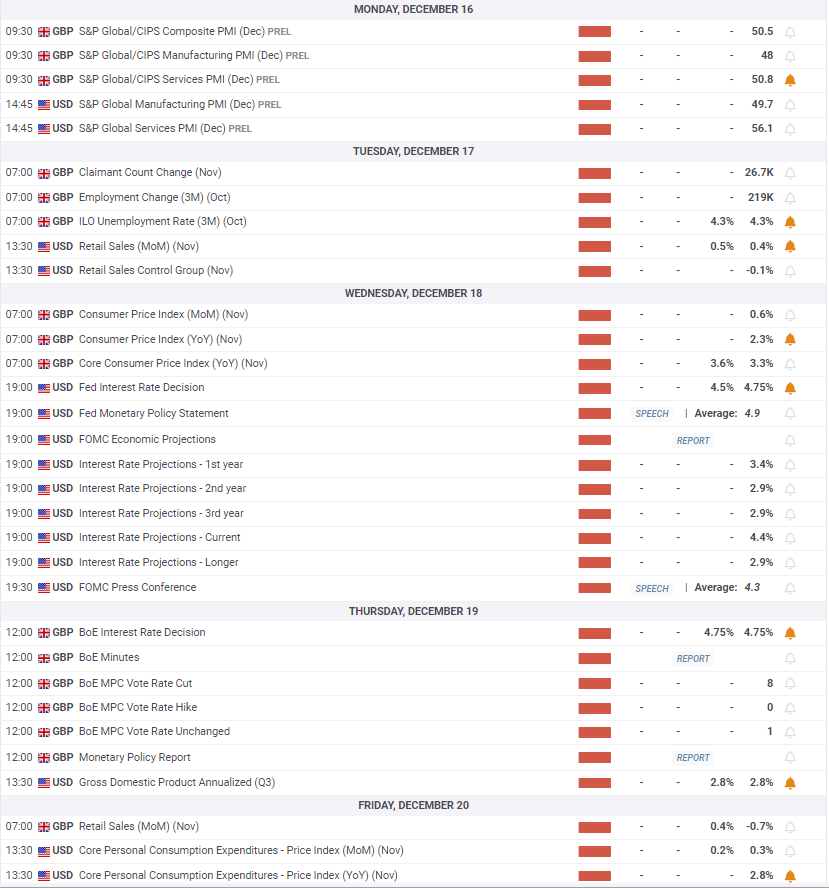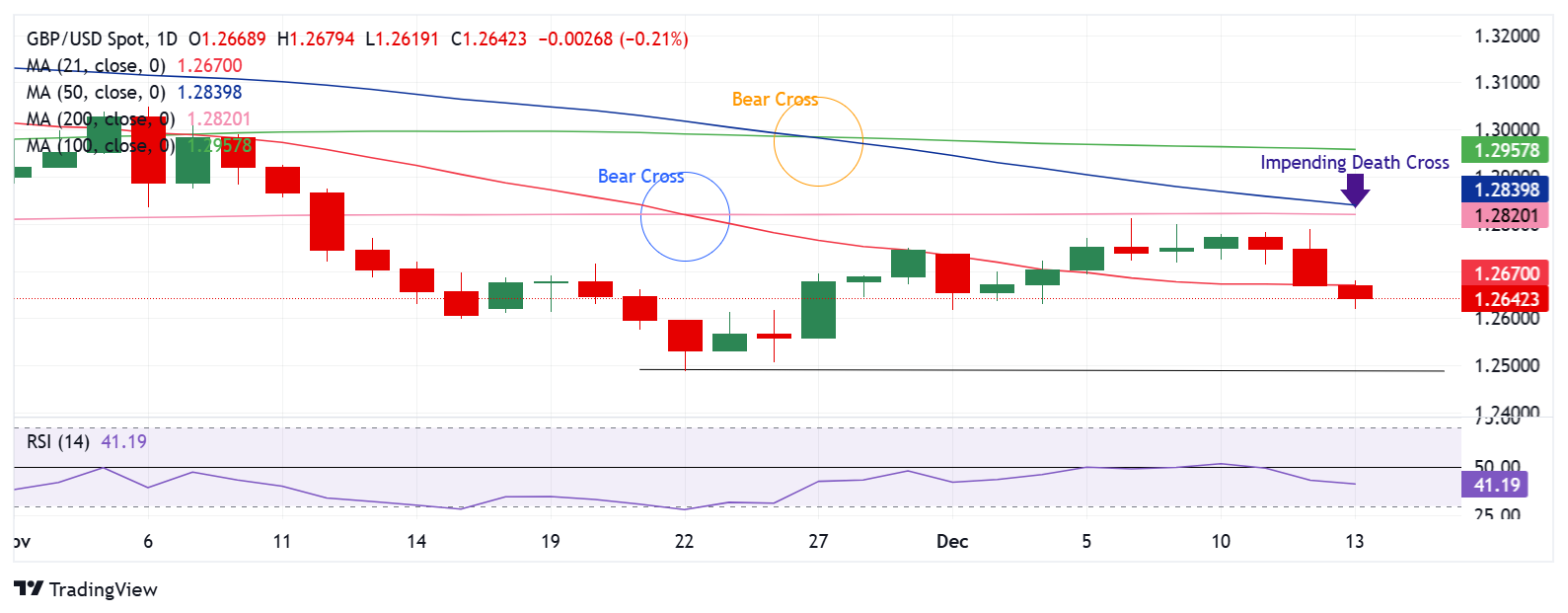- The Pound Sterling hit three-week highs against the US Dollar but then corrected.
- GBP/USD gears up for the Fed and BoE policy announcements, the grand finale for 2024.
- Pound Sterling buyers will likely stay reluctant below the key 200-day SMA at 1.2820.
The Pound Sterling (GBP) failed to sustain at three-week highs against the US Dollar (USD), sending GBP/USD back under the 1.2700 threshold.
Pound Sterling gave into persistent US Dollar demand
It was a mixed week for GBP/USD traders. In the early part of the week, the Pound Sterling defended the previous week’s upswing only to surrender into persistent USD demand in the second half. A hawkish shift in the expectations of the US Federal Reserve’s (Fed) future interest rate path and the sustained advance in US Treasury bond yields kept the Greenback’s bullish undertone alive throughout the week.
At the start of the week, the US Dollar picked up fresh haven demand as renewed geopolitical tensions emerged in the Middle East and amid China’s economic worries. This stalled the GBP/USD recovery at 1.2800. The sudden collapse of Syria's government occurred over the weekend after Syrian rebels seized the capital, Damascus, ousting President Bashar al-Assad, who fled to Russia with his family seeking asylum. The toppling of Assad’s government ended a 13-year civil war and raised concerns over the political stability in the region.
Moving on, US Consumer Price Index (CPI) data on Wednesday aligned with market expectations, while Thursday's Producer Price Index (PPI) inflation data came in hotter-than-expected and fuelled expectations that the Fed could turn to a wait-and-see policy approach after the expected 25 basis points (bps) interest-rate reduction next week.
Data showed that the US annual headline and core CPI rose by 2.7% and 3.3%, respectively, while on a monthly basis, both figures increased by 0.3%. On the other hand, The annual PPI rose 3.0% in November, above the market expectation of a 2.6% growth. Meanwhile, the annual core PPI rose 3.4% in the same period, surpassing the estimate of 3.2%. The headline PPI and the core figure rose 0.4% and 0.2% over the month, respectively.
Exacerbating the pain in the GBP/USD pair, ample supply in the US bond market kept the US Treasury bond yields northbound and the Greenback at the monthly top against its major rivals. The US Treasury Department saw good demand for a $39 billion sale of 10-year notes, the final sale of $119 billion in coupon-bearing sales after a solid $58 auction of three-year notes on Tuesday. Furthermore, the latest data showed that the US government posted a $367 billion budget deficit for November, up 17% from a year earlier.
The fresh leg higher in the USD triggered a corrective decline in the Pound Sterling heading into the weekend, with the UK Gross Domestic Product (GDP) report for October adding to the GBP downside. The UK economy unexpectedly contracted 0.1% month-over-month (MoM) in October, compared to the expected 0.1% growth. The UK Industrial and Manufacturing Production also declined 0.6% MoM in the same period.
The Fed and BoE grand finale awaited
The final full week of this year appears nothing short of a blockbuster one, filled with top-tier UK and US economic data and central banks’ policy announcements.
Monday starts with the preliminary S&P Global Manufacturing and Services PMI data from both sides of the Atlantic, while Chinese activity data will also be closely eyed.
The UK labor market report will be published on Tuesday, followed by the US Retail Sales and Industrial Production data.
Wednesday will feature the UK inflation report, followed by the all-important Fed interest rate decision, Dot Plot chart and Chairman Jerome Powell’s press conference.
The BoE policy verdict will stand out on Thursday amid the weekly Jobless Claims and Existing Home Sales data releases.
The UK Retail Sales and the US core Personal Consumption Expenditure (PCE) Price Index will wrap up an eventful week.
Also of note will remain the Middle East geopolitical developments and global trade updates.
GBP/USD: Technical Outlook
GBP/USD sellers refused to give up as the previous week’s recovery attempt fizzled out shy of the 200-day Simple Moving Average (SMA) at 1.2820.
An impending death and the previous dual Bear crosses will likely continue to cause headwinds in the Pound Sterling in the coming days.
The 50-day SMA is on the verge of crossing the 200-day SMA from above, which, if it occurs, will validate the Death Cross.
Further, the 14-day Relative Strength Index (RSI) has returned to negative territory at around 40, backing the case for additional downside.
The Pound Sterling must crack the 200-day SMA at 1.2820 to reverse the renewed downward momentum.
The next relevant upside target aligns near 1.2850, the confluence of the psychological level and the 50-day SMA.
Fresh buying interest could emerge on a sustained move above the latter, opening the door for a test of the 1.2900 round figure, followed by the 100-day SMA at 1.2958.
Contrarily, if the selling intensifies, the previous week’s low of 1.2617 will be tested, below which the six-month low of 1.2488 will be put to the test.
The line in the sand for buyers is seen at the 1.2400 round figure.
BoE FAQs
The Bank of England (BoE) decides monetary policy for the United Kingdom. Its primary goal is to achieve ‘price stability’, or a steady inflation rate of 2%. Its tool for achieving this is via the adjustment of base lending rates. The BoE sets the rate at which it lends to commercial banks and banks lend to each other, determining the level of interest rates in the economy overall. This also impacts the value of the Pound Sterling (GBP).
When inflation is above the Bank of England’s target it responds by raising interest rates, making it more expensive for people and businesses to access credit. This is positive for the Pound Sterling because higher interest rates make the UK a more attractive place for global investors to park their money. When inflation falls below target, it is a sign economic growth is slowing, and the BoE will consider lowering interest rates to cheapen credit in the hope businesses will borrow to invest in growth-generating projects – a negative for the Pound Sterling.
In extreme situations, the Bank of England can enact a policy called Quantitative Easing (QE). QE is the process by which the BoE substantially increases the flow of credit in a stuck financial system. QE is a last resort policy when lowering interest rates will not achieve the necessary result. The process of QE involves the BoE printing money to buy assets – usually government or AAA-rated corporate bonds – from banks and other financial institutions. QE usually results in a weaker Pound Sterling.
Quantitative tightening (QT) is the reverse of QE, enacted when the economy is strengthening and inflation starts rising. Whilst in QE the Bank of England (BoE) purchases government and corporate bonds from financial institutions to encourage them to lend; in QT, the BoE stops buying more bonds, and stops reinvesting the principal maturing on the bonds it already holds. It is usually positive for the Pound Sterling.
Information on these pages contains forward-looking statements that involve risks and uncertainties. Markets and instruments profiled on this page are for informational purposes only and should not in any way come across as a recommendation to buy or sell in these assets. You should do your own thorough research before making any investment decisions. FXStreet does not in any way guarantee that this information is free from mistakes, errors, or material misstatements. It also does not guarantee that this information is of a timely nature. Investing in Open Markets involves a great deal of risk, including the loss of all or a portion of your investment, as well as emotional distress. All risks, losses and costs associated with investing, including total loss of principal, are your responsibility. The views and opinions expressed in this article are those of the authors and do not necessarily reflect the official policy or position of FXStreet nor its advertisers. The author will not be held responsible for information that is found at the end of links posted on this page.
If not otherwise explicitly mentioned in the body of the article, at the time of writing, the author has no position in any stock mentioned in this article and no business relationship with any company mentioned. The author has not received compensation for writing this article, other than from FXStreet.
FXStreet and the author do not provide personalized recommendations. The author makes no representations as to the accuracy, completeness, or suitability of this information. FXStreet and the author will not be liable for any errors, omissions or any losses, injuries or damages arising from this information and its display or use. Errors and omissions excepted.
The author and FXStreet are not registered investment advisors and nothing in this article is intended to be investment advice.
Recommended Content
Editors’ Picks

EUR/USD extends slide toward 1.0300, touches new two-year low
EUR/USD stays under bearish pressure and trades at its lowest level since December 2022 below 1.0350 on Thursday. The pair turned south amid a resurgent US Dollar demand and worsening market mood. Investors stay cautious at the onset of 2025, awaiting the US jobs data for fresh incentives.

GBP/USD slumps to multi-month lows below 1.2450
Following an earlier recovery attempt, GBP/USD reversed its direction and declined to its weakest level in nearly eight months below 1.2450. The renewed US Dollar (USD) strength on worsening risk mood weighs on the pair as markets await mid-tier data releases.

Gold benefits from risk aversion, climbs above $2,640
Gold gathers recovery momentum and trades at a two-week-high above $2,640 heading into the American session on Thursday. The precious metal benefits from the sour market mood and the pullback seen in the US Treasury bond yields.

XRP rockets 11% as Bitcoin starts New Year with bullish bang
Crypto majors zoomed higher in the past 24 hours as the market entered a widely expected bullish year, with Bitcoin inching above $95,000 to shake off losses from last week. XRP surged 11% to lead growth among majors as of Thursday, led by $1.3 billion worth of trading volumes on Korea-focused exchange UpBit.

Three Fundamentals: Year-end flows, Jobless Claims and ISM Manufacturing PMI stand out Premium
Money managers may adjust their portfolios ahead of the year-end. Weekly US Jobless Claims serve as the first meaningful release in 2025. The ISM Manufacturing PMI provides an initial indication ahead of Nonfarm Payrolls.

Best Forex Brokers with Low Spreads
VERIFIED Low spreads are crucial for reducing trading costs. Explore top Forex brokers offering competitive spreads and high leverage. Compare options for EUR/USD, GBP/USD, USD/JPY, and Gold.

